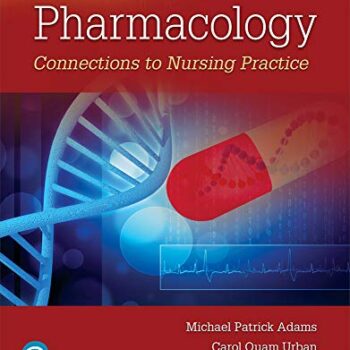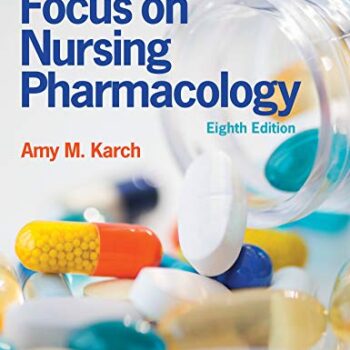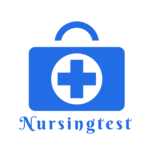
Test bank For Pharmacology For Nurses A Pathophysiologic Approach 5th Edition by Michael Patrick Adams
Original price was: $65.00.$40.00Current price is: $40.00.
Digital item No Waiting Time Instant DownloadISBN 10: 013425516X ISBN-13: 9780134255163
Test Bank for Pharmacology for Nurses: A Pathophysiologic Approach, 5th Edition by Michael Patrick Adams is useful in exam preparation, and as study material for an in-depth understanding of pharmacology. This test bank is made for nursing students and has a good variety of practice questions that relate to what has been studied in the book. This will assist students in both comprehension and application of concepts during clinical tests even in case of an upcoming exam.
Key Topics Covered in the Test Bank
This test bank lets them delve into almost all the topics that are necessary to learn pharmacology. The questions are based on drug classes, forms, routes, and drug pharmacokinetics and pharmacodynamics. These core concepts are critical for understanding how drugs work within the body and how drugs affect different systems.
- Drug Regulation and Approval – Questions ask about the steps taken to test and approve drugs and why such steps are relevant.
- Pharmacokinetics – The branch that explains the distribution of drugs, their metabolism, elimination, and overall uptake by the body.
- Pharmacodynamics – This part explains various interactions of drugs with the body which helps them appreciate the processes involved in the drug activities.
- Nursing Process in Pharmacology: This section covers questions like, how do nurses go about the nursing process while administering drugs? Is it safe, and is it effective?
- Substance Abuse – This section studies the context of drug abuse and how trained professionals, and nurses, can solve such drug abuse issues.
Focus on the Test Bank
The test bank is created to reflect various exams and the questions found in these exams. There is a variety of questions, like Multiple choice questions, true/false and fill in the gap. Such variation is beneficial in that it prepares you for the various types of assessments as well as the understanding of the material as a whole.
The rationales for the questions of each key point are also one of its great advantages. These clarifications bring about the understanding of not only the correct answer but also other options and their reasons, which adds up to the learning and the retention of the information to be transferred. This is especially useful in areas like determining drug interactions, doses, and adverse side effects where the concepts behind the principles matter.
The Convenience of Using the Test Bank
One of the greatest appeals of this test bank is the fact that is suitable for students with busy schedules. This, in turn, reduces the pressure on students and allows them to try and study effectively. Since this test bank is available formatted in a download format, students can access this document at any time and from someplace without any constraints on their geographical location. There is no geographical bias present within the test bank and so students studying at the extreme edge of the globe are not disadvantaged in any manner. The test bank is active and supportive of students and allows all students to be able to make use of it while embarking on their daily activities. There is also a correlation that matches all questions and materials available in the book so students can better understand the questions and be as precise as possible.
This test bank is beneficial since it encompasses a variety of systems such as the nervous system, the cardiovascular system as well as the immune system. With this kind of preparation, perfection in practice is guaranteed regardless of the areas of specialization. It also focuses on sensitive issues such as drug errors, risk management, and drug administration across the life span which are important aspects in nursing practices.
Summary
The test bank for Pharmacology for Nurses: A Pathophysiologic Approach 5th Edition is a very important asset. It’s no secret that pharmacology is one of the most challenging units that a nurse takes. This, however, should not be a cause for concern, as this particular test bank contains all relevant information about the field. It contains information about the basic concepts of every master topic as well as where to find the information, practice, and explanation that is necessary. All of this information is relevant to the core concepts of pharmacology, as excessive content will dilute the retention level. The fact that everything is in a digital form is comforting for many college students as they are very mobile and always on the go.
Test Bank For Pharmacology For Nurses A Pathophysiologic Approach 5th Edition by Michael Patrick Adams
Adams, Pharmacology for Nurses: A Pathophysiologic Approach, 5/EChapter 2
Question:1
Type: MCSA
The pharmaceutical representative comes to the physician’s office and says his company’s pharmaceutical laboratory is marketing a drug that does not need approval by the Food and Drug Administration (FDA). What is the best response by the nurse?
1. “Any pharmaceutical laboratory in America must have approval from the Food and Drug Administration (FDA) before marketing a drug.”
2. “Is this an over-the-counter (OTC) drug? They do not need approval by the Food and Drug Administration (FDA).”
3. “Is your pharmaceutical laboratory private? Only public pharmaceutical laboratories need approval from the Food and Drug Administration (FDA).”
4. “Your pharmaceutical laboratory must be involved in academic research because they are exempt from approval by the Food and Drug Administration (FDA).”
Correct Answer: 1
Rationale 1: Any pharmaceutical laboratory must obtain approval from the Food and Drug Administration (FDA) before marketing a drug.
Rationale 2: Pharmaceutical laboratories that manufacture over-the-counter (OTC) drugs must obtain approval from the Food and Drug Administration (FDA) before marketing these drugs.
Rationale 3: Private pharmaceutical laboratories must obtain approval from the Food and Drug Administration (FDA) before marketing a drug.
Rationale 4: Pharmaceutical laboratories involved in academic research must obtain approval from the Food and Drug Administration (FDA) before marketing a drug.
Global Rationale: Any pharmaceutical laboratory, whether private, public, or academic, must obtain approval from the Food and Drug Administration (FDA) before marketing a drug. Private pharmaceutical laboratories must obtain approval from the Food and Drug Administration (FDA) before marketing a drug. Pharmaceutical laboratories involved in academic research must obtain approval from the Food and Drug Administration (FDA) before marketing a drug. Pharmaceutical laboratories that manufacture over-the-counter (OTC) drugs must obtain approval from the Food and Drug Administration (FDA) before marketing these drugs.
Cognitive Level: Applying
Client Need: Physiological Integrity
Client Need Sub: Pharmacological and Parenteral Therapies
QSEN Competencies: V.B.1 Demonstrate effective use of technology and standardized practices that support safety and quality.
AACN Essential Competencies: V.4 Examine legislative and regulatory processes relevant to the provision of health care.
NLN Competencies: Quality and Safety: Policies and procedures.
Nursing/Integrated Concepts: Nursing Process: Implementation
Learning Outcome: 2-2 Discuss the role of the U.S. Food and Drug Administration (FDA) in the drug approval process.
MNL Learning Outcome: 1.1.1 Apply basic concepts related to pharmacology.
Page Number: 13
Question 2
Type: MCSA
The nurse is employed by the Food and Drug Administration (FDA) and is involved in clinical investigation. What is the primary role of the nurse in this phase of the review and approval process by the FDA?
1. To perform tests on the population-at-large
2. To perform tests on various species of animals
3. To perform tests on human cells cultured in the laboratory
4. To perform tests on human clients
Correct Answer: 4
Rationale 1: Performing tests on the population at large is the stage of post-marketing surveillance.
Rationale 2: Performing tests on various species of animals is the preclinical investigation stage.
Rationale 3: Performing tests on human cells cultured in the laboratory is the preclinical investigation stage.
Rationale 4: Clinical investigation includes performing tests on healthy volunteers, and later, on selected clients with a particular disease.
Global Rationale: Clinical investigation includes performing tests on healthy volunteers, and later, on selected clients with a particular disease. Performing tests on human cells cultured in the laboratory is the preclinical investigation stage. Performing tests on the population at large is the stage of post-marketing surveillance. Performing tests on various species of animals is the preclinical investigation stage.
Cognitive Level: Applying
Client Need: Physiological Integrity
Client Need Sub: Pharmacological and Parenteral Therapies
QSEN Competencies: V.B.1 Demonstrate effective use of technology and standardized practices that support safety and quality.
AACN Essential Competencies: V.4 Examine legislative and regulatory processes relevant to the provision of health care.
NLN Competencies: Quality and Safety: Policies and procedures.
Nursing/Integrated Concepts: Nursing Process: Implementation
Learning Outcome: 2-5 Identify the nurse’s role in the drug approval process and in maintaining safety practices.
MNL Learning Outcome: 1.1.1 Apply basic concepts related to pharmacology.






